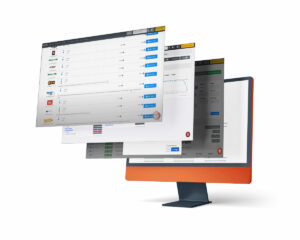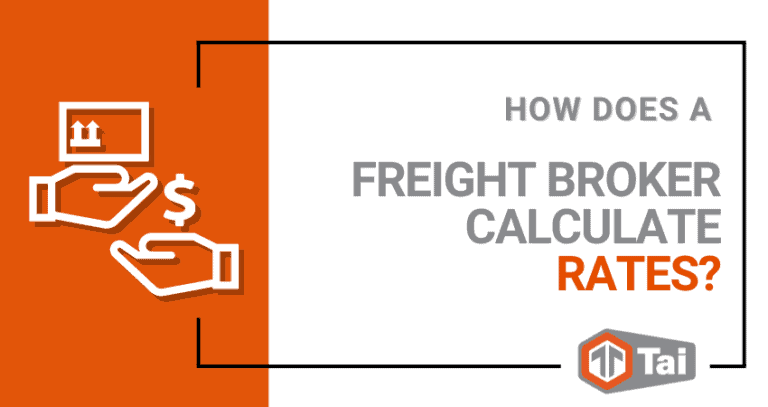So... how does a freight broker calculate rates accurately?
A big part of a freight broker’s job is to know how much a load should actually cost to move. This determines how much you should expect to pay the carrier and how much your shipper should expect to be billed for. The tough question is, how does a broker calculate rates accurately and fairly?
The trucking and domestic freight markets being historically inconstant, plus the cumulative effects of the 2017 Capacity Crisis and the 2020 COVID-19 pandemic, and other factors, have led to even more volatility within the Supply Chain. Even the carriers that provide their services on the same lanes are having cost fluctuation that causes freight rates to vary significantly.
So, is the secret to pricing loads memorization? Or repetition, knowing what a load is worth on a particular lane and repeating the same process over and over again? Can a freight broker calculate rates using a simple black-and-white procedure that you can use and reuse for every single load? Is it directly correlated to the weight and distance the load is moving? Or are there other factors to be aware of that influence the rates, making the practice of quoting dynamic and ever-changing? Well, the answer is yes to all and no to all.
Things can become even more complicated when the freight carrier is not as transparent as it should be. Hidden costs and other concealed extra charges can drive up the freight cost, affecting both the licensed freight broker’s business and client relationships, especially if their load is delayed or comes in overpriced.
There’s a lot that goes into accurately quoting a brokered load, ranging from stable, repeatable techniques and formulas, all the way to dynamic factors that can vary significantly throughout the year.
It is important to be on top of ALL of these factors, if you’re not, it’s going to be quite the challenge to both get a fair price for your shipper AND reach a fair price with a carrier.
Let’s walk through the manual process of quoting a brokered load.
Your basic full truckload (FTL) freight is typically a standard box trailer with minimal additional requirements other than moving the trailer from point A to point B.
Freight Brokers that are starting out will have to do a lot of the quoting tasks manually. For a broker to calculate rates there are several negatives to manual quoting, slow turn-around, pricing errors, and perceived bad customer service. That being said, brokers can reach out to their network of carriers and other brokers to get an “in-the-ballpark” per-mile quote. Your shippers will typically give an overall rate, so you will need to do the math on the distance and cost to transport to deliver the load to determine your initial quote.
Step 1 – Determine the per-mile rate for the shipper quote
Calculate the mileage between the starting and destination points, Google Maps can give you an accurate distance. Divide the overall rate you got from the shipper and the number of miles from the start to the destination. The most basic of rates will be ($X.00 shipper offer) / X miles = $X.00 per-mile rate.
Step 2 – Figure out the cost to transport
Calculate the fuel costs. If on average, a truck gets 6 mpg. Take the total mileage and divide it by MPGs: X miles / 6 mpgs = X gallons of diesel needed for the delivery. Find the current per gallon cost for diesel, $x.oo and multiply by the number of gallons needed to determine transport cost. ($X.00 per gallon) x (X gallons) needed to complete the delivery.
Step 3 – Determine labor cost
This one is a little tricky, some fleets pay an hourly rate, but the majority pay their drivers by the mile. If the carrier pays hourly, determine the average mile per hour and divide by the total delivery mileage. (Total miles / avg. miles per hour = Hours needed to complete the delivery) then take the hours and multiply by the (hourly rate X hours x $X.00) = $X.00 driver fees.
If the driver is paid per mile (you will need to reach out to your network for current per-mile rates) multiply total miles by cost per mile (X miles x $x.00 per mile) = $X.00 driver fees.
Step 4 – Determine your basic costs for brokering the load
Add the gas cost and the truck driver pay $X fuel fees + $1X driver fees = $X.00. Now divided the total miles by your costs to arrive at the per mile cost, X miles / $X.00 cost = $per mile cost.
Step 5 – Determine potential per-mile profit
As a broker calculates rates, they add 15-20% to the quote to cover the costs of doing business and profit. Take the total from step 4 $X.00 and multiply by 1.2, $x.00 x 20% = $initial quote
Step 6 – Now the hard part starts
If you don’t get back to your customer quickly, you will most likely miss out on that opportunity. One important thing to note though, this is only the START PAY or the STARTING point for the negotiation. In 99% of cases, this calculated rate will just be the first number you pitch to the carrier, in which case they will counter with a significantly higher price (and thus begins the negotiation).
By having access to accurate and real-time market information, brokers are armed with a more predictable benchmark to help calculate freight rates, empowering them to find trustworthy trucking companies that will not overcharge or underperform in terms of their freight services.
See how the Tai TMS automates quoting for you, with 20% more accuracy than the industry average while giving your reps the time to cover more loads.
Given the many changes that occur regularly, which can include human error, unpredictable weather events, changes in slated programs, and more, the responsibility will eventually fall on the freight broker to ensure that deliveries take place on time and that everything goes without a hitch.
Shipping domestic goods without actually taking into consideration the additional costs is never a good idea when you calculate freight rates. Freight brokers always need to take into account these key factors to help the broker calculate rates.
Here are some other elements to help a broker calculate rates for both FTL and TLT freight
As mentioned above, several factors influence how a broker calculates rates. These will include the shipping distance, the overall size of the goods, the urgency of transportation, temperature requirements, or shipment classification. And given the average trucking company has around only one or two trucks available at any given time, there can be a huge price variance.
-
- Travel Distance – Usually, the more distance the shipment has to cover during transportation, the higher the freight rate. The main reason for this price increase will be due to the overall fuel cost.
-
- Shipment Weight – Another key component that will impact the freight cost is the overall weight. The heavier the shipment, the lower the charge per hundred dollars, but the higher the overall cost. As the shipment’s weight goes up and comes closer to the next weight category’s minimum load weight, the shipment will be rated in the next category for having a low weight for that category.
-
- Shipment Density – When determining the trucking rate, the shipment density also plays an important role. The density is usually calculated accurately and will describe the goods being shipped in the Bill of Lading. The typical density for your average trucking shipment is calculated by dividing the weight by the volume. When it comes to palletized loads, the dimensions are also used in addition to the weight when calculating the density.
-
- Freight Classification – It’s essential to keep in mind that every cargo has a specific classification that will impact the general trucking rate. In the United States, the National Motor Freight Traffic Association (NMFTA) classifies these as less-than-truckload (LTL) and full-truckload (FTL) in its National Motor Freight Classification book. There are, in total, 18 different classes, which extend from 50 to 500. Each freight class is determined based on the cargo’s value, handling, stability, density, and liability.
Base Rates and Minimums When Dealing with a Freight Shipper
Every carrier has its established base rate for shipments. And even if most of these rates are cited per $100, they can vary based on the carrier and transporting lane. They will also change their base rates if they are required to carry extra volume.
Aside from pricing, a licensed freight broker business also needs to have an in-depth understanding of the terminology when dealing with a shipper or freight carrier. Below is a rundown of some of the most commonly used terms used when you calculate freight rates.
-
- Carrier – Asset-based company that offers transportation services.
-
- Bill of Lading – Also known as a freight bill, Bol, or B/L, the bill of lading is a record of the agreement between the shippers and carriers, highlighting all the freight shipping services provided.
-
- Consignor – Either an individual or trucking company that sends freight to the consignee.
-
- Consignee – An individual or trucking company that gets the freight from the consignor.
-
- Loss and Damage – The loss and damage rates cover only shipments in transit or storage for a brief period and where the facility is owned and operated by the carrier.
-
- Full Truckload (FTL) – These are shipments that need an entire trailer to haul goods.
-
- Less than Truckload (LTL) – Shipments that do not need to use the full capacity of a trailer.
-
- Drayage – refers to the movement of trailers and containers to and from railroads and seaports through the trucking method exclusively.
-
- Pallets – These are stacking platforms that measure 48″ by 40″.
-
- Stock Keeping Unit (SKU) – These are numbers given to products for carrying out operations and tracking purposes. A stock-keeping unit serves as a unique identifier for each product, which, in turn, helps to identify the product quickly..
-
- CWT (Centum Weight) – A typical weight unit equivalent to 100 pounds and used in the industry.
Many carriers have large and complex books that sketch out various hidden charges and rules that can influence the way a broker calculate rates and their overall cost. These will typically fall under the Rules Tariff section of the book. There are a couple of factors that will impact these charges.
Customers must get a full trucking freight quote before they proceed with a carrier. For this reason, it is important to work with a licensed broker that will be able to identify all of these hidden charges.
How Does a Growing Freight Broker Calculate Rates with a TMS?
As a brokerage grows, manual processes make it harder and harder to scale. A rep can manage only so many loads, and finding more reps becomes harder and harder to do. But, there are several tech tools available to help a broker calculate rates and cover more loads (one of Tai’s customers increased LTL coverage by 4X.) Tech that helps freight brokers calculate freight rates for full truckload.
- A good broker TMS will provide you with access to the load boards without having to leave the TMS.
- Access to load boards such as greenscreens.ai, Truckstop.com or DAT.com as the most highly recommended load boards. These load boards have built-in rating tools that give freight brokers the necessary intelligence to save them plenty of time while calculating their customers’ rates. The majority of load boards that contain useful rating information will require a subscription. That said, every licensed freight brokerage company will need to invest in such load boards and rating tools if they wish to provide the best kind of services to their clients.
Also, most load boards will provide freight brokers with the ability to search lane histories. Traditionally, this used to be the favored method of sourcing carriers and getting rates for any given lane. Load board lane histories will typically show carriers posting truck availability, which is based on specific lanes. If a truck is posted as available, they want or need loads on that lane. But rather than focusing on a single load, freight brokers can better invest their time by developing relationships with the carrier.
Another option is to post a load or lane on the aforementioned load boards. If the lane is desirable, carriers are bound to start calling looking for your freight. However, during the call, you must gather as much intelligence as possible on both rates and availability. While some people are not in favor of this strategy, it can still be a worthwhile option to gather quick rating information.
To get shippers, the freight broker will need to understand that the rates are ultimately determined by supply and demand. To be more specific, brokers calculate freight rates as a ratio between trucks and loads in any given area or lane. But thanks to the many advancements made in logistics technology, freight brokers will have a much better time understanding these rates.
For example, the Tai TMS Software is one such freight broker software that provides its users with all the features necessary to manage the full lifecycle of their loads. It’s a cloud-based solution that uses Artificial Intelligence (AI) to facilitate its users with a centralized location from which they can use automation to calculate freight rates, track shipping, rate and onboard carriers, and perform accounting processes. Load boards and carriers are integrated directly into the TMS so the broker isn’t jumping from platform to platform. In doing so, Tai Software makes it that much easier for freight brokers to train new hires and scale their operations.
Tai Software will analyze millions of data variables in real-time and will allow companies to calculate freight rates with the click of a button and increase their operational efficiency within the transportation and freight industry. It’s a solution that addresses every aspect of the shipment lifecycle, making it a broker-focused great TMS software platform, not only for freight brokers and 3PLs but for freight forwarders, and large shippers alike. Request a free demo today!
variables in real-time and will allow companies to calculate freight rates with the click of a button and increase their operational efficiency within the transportation and freight industry. It’s a solution that addresses every aspect of the shipment lifecycle, making it a broker-focused great TMS software platform, not only for freight brokers and 3PLs but for freight forwarders, and large shippers alike. Request a free demo today!










